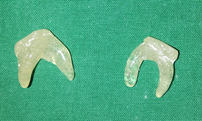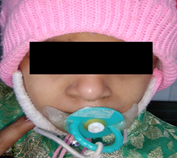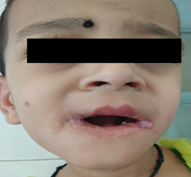Introduction
Microstomia is an unusual condition characterized with abnormally small or insufficient oral aperture which can be attributed to congenital or acquired etiological factors. Literature states that during 1990s, electric and chemical oral burns were common cause of microstomia in children [1]. Such injuries cause adhesion of lips, constriction of lip commissure and generalized contracture of wound while healing thereby leading to scarring, deformation and lastly microstomia [2]. The inadequate oral opening hampers facial expression, oral feeding, speech and oral hygiene maintenance there by compromise aesthetics, psychological health and quality of life of an individual. Furthermore, difficulty in oral hygiene results in increased incidence of oral diseases such as caries, periodontal diseases and other infections, with limited scope for treatment [3].
The detrimental effects of microstomia can be managed by complex surgery followed by prosthodontics intervention as Microstomia prevention appliance. Microstomia prevention appliance is a commissural retractor by which its horizontal forces restrict contraction of tissue during healing and prevent microstomia [1]. Literature describes various types of microstomia prevention appliances indicated in variable clinical scenario, selection of which depends on the age of patient and dentition status. However, certain unusual clinical condition may demand modification or innovation for successful treatment. This paper presents one such distinctive approach to prevent microstomia in 2 year old female patient following lip surgery.
Case Report
A 2 year old female reported to Department of Prosthodontics, Government Dental College and Research Institute, Bangalore with complaint of limited mouth opening since 1 year. Patient was accompanied by her parents who reported that 1 year back patient suffered from fever which was also associated with blisters at corner of lips. Subsequently, they applied an over the counter medicated ointment over the blister on lip commissures which lead to burn followed by progressive scaring, contracture and limited the mouth opening. Patient then underwent surgery to relieve microstomia which was successful but never approached any prosthodontist for any appliance for prevention of microstomia resulting in contracture of tissue and relapse of microstomia.
On examination, the mouth opening of patient was about 1cm with shallow lower anterior labial vestibule (Figure 1). There was generalized loss teeth structure due to carious lesion owing to minimal mouth opening and inadequate oral hygiene practice. Considering the severity of microstomia, patient was planned for surgical release of microstomia followed by insertion of microstomia prevention appliance.

Figure 1: Patient in outpatient department.
In this case, fixed or removable tooth borne appliance was first considered, however insufficient sound teeth contraindicated its fabrication. Extraoral headgear appliance was also excluded due to aesthetic consideration and lack of patient compliance. Hence, customized microstomia prevention was fabricated understanding the clinical state.
Procedure
Patient was posted for surgery immediately after which an impression was made using putty based addition silicon impression material in metallic check retractor of lip commissure (Figure 2). Following this the impression is replicated using alginate material to prepare molds for fabrication of lip conformer. Denture relining material was then injected into the both molds and allowed to set. Subsequently both the lip conformers were retrieved and finished (Figure 3).

Figure 2: Surgery and impression.

A pre-fabricated pacifier for kid was used to make this microstomia prevention appliance. The horizontal length of oral aperture was estimated using vernier caliper. The lip conformers were then adjusted and attached to pacifier to achieve the measured horizontal length of oral aperture. The lip conformer is attached to pacifier using chemically polymerized poly(methyl methacrylate) resin (Figure 4). The customized microstomia prevention appliance was then tried in patient mouth and finished and inserted (Figure 5).

Figure 4: Customized microstomia prevention appliance.

Figure 5: Appliance insertion.
Patient was instructed to wear the appliance throughout the day and night except during meals. Patient was regularly followed up at weekly intervals. After initial healing period that is around 15 days, the soft reliner was replaced with clear chemically polymerized poly(methyl methacrylate) resin. Four months following surgery, the horizontal length of oral aperture was well maintained at around 5 cm (Figure 6). Patient was followed up with three months post-surgery and one year after surgery (Figure 7).

Figure 6: Four months follow up.

Discussion
Post-surgical management of microstomia is a crucial component of treatment as comprehended in present case. Any negligence in institution of microstomia prevention appliance can lead to relapse of microstomia and failure of surgical procedure. The basic foundation of these appliances as stated by Holt et al. relies on ability of oral sphincter to respond to external distracting forces [4]. A plethora of diverse microstomia prevention appliances are documented in the literature. Decision to use a particular appliance in management of these patients should be planned mutually by the physician and prosthodontics that are familiar with the efficacy and effectiveness of the appliances and various patient factors like age, dentition status and compliance.
Microstomia prevention appliances can be categorized as static or dynamic appliance. Static devices act as commissural splint during healing period and dynamic device are the one which provide retracting forces [5,6]. These appliances can also be grouped as whether they are intraoral or extraoral and removable or fixed [7]. Present appliance can be classified as static extra oral removable microstomia prevention appliance.
Josell et al, in 1984 underlined the various requirement of ideal appliance which were, 1) Simple, non-traumatic, and inexpensive to fabricate; (2) Easily inserted and removed with minimal discomfort to patient; (3) Well tolerated by patient, comfortable to wear, and compatible with appliance-bearing tissue; (4) Retentive and well-adapted at the site of injury [8]. The present customized microstomia appliances meet all the above criteria to the completest.
The appliance therapy used in present case was acceptable to the child in spite of her young age and lack of cooperative behavior. In addition, it was easy to fabricate at minimal time lost following surgery. Also, it allows hassle-free periodic correction and adaption for improved results in prevention of microstomia.
References
1. Silvestre RJ, Herrera MM and Silvestre FJ. Dental management of patients with microstomia. A review of the literature and update (2015) J Oral Res 4: 340-350.
https://doi.org/10.17126/joralres.2015.065
2. Le Compte EJ and Barry M. Oral electrical burns in children-early treatment and appliance fabrication (1982) Pediatr Dent 4: 333.
3. Antonarakis GS, Fastlicht S, Masnyi T and Tompson B. Postburn Microstomia Prevention Using an Appliance Providing Simultaneous Horizontal and Vertical Adjustable Forces (2017) J Burn Care Res 38: e977-e982.
https://doi.org/10.1097/BCR.0000000000000523
4. Holt GR, Parel S, Richardson DS and Kittle PE. The prosthetic management of oral commissure burns (1982) Laryngoscope 92: 407-411. https://doi.org/10.1288/00005537-198204000-00009
5. Nitzan DW, Azaz B and Constantini S. Severe limitation in mouth opening following transtemporal neurosurgical procedures: diagnosis, treatment, and prevention (1992) J Neurosurg 76: 623-625.
https://doi.org/10.3171/jns.1992.76.4.0623
6. Sadrimanesh R, Hassani A, Vahdati SA, Chaghari H, Sadr-Eshkevari P, et al. Freeman-Sheldon syndrome: Combined surgical and non-surgical approach (2013) J Cranio-Maxillofac Surg 41: 397-402. https://doi.org/10.1016/j.jcms.2012.11.004
7. Linebaugh ML and Koka S. Oral Electrical Burns: Etiology, Histopathology, and Prosthontic Treatment (1993) J Prosthodont 2: 136-141. https://doi.org/10.1111/j.1532-849X.1993.tb00396.x
8. Josell SD, Owen D, Kreutzer LW and Goldberg NH. Extraoral management for electrical burns of the mouth (1984) ASDC J Dent Child 51: 47-52.
*Corresponding author
Mohammed Ajmal, Senior Lecturer, Department of Prosthodontics, KGF College of Dental Sciences, BEML Nagar, Kolar Gold Fields, Kolar, Karnataka 563115, India, E-mail: drmdajmal@gmail.com
Citation
Ajmal M, Kaur M, Saleem M and Premnath K. Customized microstomia prevention appliance therapy: a case report (2019) Dental Res Manag 3: 42-44
Keywords
Appliance therapy, Dental care, Microstomia


 PDF
PDF